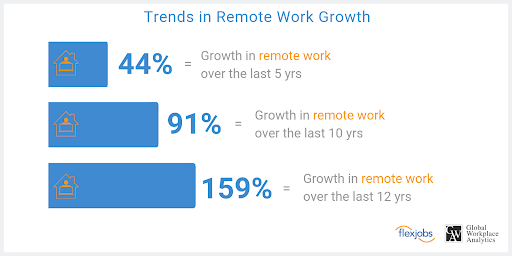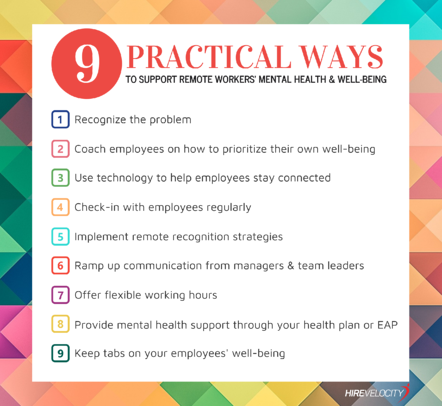9 Most Common Mistakes Managing Remote Workforce (And What To Avoid)

The business world has changed a lot in recent years. New, exciting technologies have transformed how we carry out our work. If you look around, you’ll probably see some of this technology in action. In fact, there’s probably a good chance that you’re reading this article on a cell phone or tablet.

We don’t even need to be sat at a desk, let alone in an office, to carry out our work. It’s fair to say that many businesses are now taking advantage of this. We’ve seen technologies such as virtual business phone solutions, which allow us to carry out tasks from the comfort of our cell phones.
You're not alone if your organisation has turned to remote work recently. 52% of employees globally work remotely at least once a week, and as many as 68% do so at least once per month.
The change was always inevitable. For one, remote work saves money. A business no longer has to rent a considerable office location. Time is also protected, and employees are no longer at risk of delays when commuting to work.
But no one said remote work would be easy. Despite this long list of benefits, many businesses struggle to transition from office work to working remotely whether it's with leadership or managing performance of a distributed team and many other arising challenges too. But what can be done?
The first step to making positive change is knowing the common mistakes business owners go through when managing a remote workforce, and how you can avoid falling into them.
1. Not treating employees equally
Most businesses haven’t abandoned in-office work completely. Instead, many organizations have chosen a hybrid system to balance management requirements with most employees' desire for a flexible online job. This means that some of your employees work in-office, and some work remotely. If you are one of these businesses, you should consider how you treat your remote teams compared to those working in the office.
Too many organisations treat in-office workers more favourably, offering them pay rises, and chances of promotion. This isn’t usually a conscious decision. The fact is, you’ll speak to in-office workers face to face every day. If you don’t make similar efforts to get to know remote employees, you won’t have the same connection.
It will do little to help the morale of your remote teams. If they aren’t going to be given the same opportunities as office workers, why should they work as hard? If you’re not careful, you’ll find yourself with a demoralised, and unmotivated remote workforce.
HR management tools are crucial for bridging the gap between in-office and remote teams. These tools facilitate consistent performance tracking, recognition, and communication, ensuring equal opportunities for all employees. By leveraging HR management tools, you can monitor performance, provide fair career growth opportunities, and maintain high morale across your workforce. Aim to treat all employees equally to keep your team engaged and motivated.
Make it your goal to treat all employees equally, and keep your workforce happy.
2. Not getting to know remote teams
Managers spend less time with remote workers. Not only that, but workers spend less time getting to know each other. To create strong teamwork, people need to know one another. This can be harder to achieve when you aren’t all in the same building.
Regular activities, like going out for drinks, aren’t possible. So, what can you do instead? The following suggestions might help.

Create a virtual breakout room
In the office, it’s common for workers to spend time chatting during breaks. But when working remotely, people generally go off and do their own thing. Employees should always be free to do what they want in their breaks. But there’s no harm in giving the option of socializing; many workers will appreciate the chance of a chat.
You can create a virtual breakout room with the right video conferencing software. Employees can hop in, and out whenever they choose. This provides an excellent opportunity for socializing, and helps to strengthen team bonds.
Have a drinks night
Going drinking with your team or having a meal is a good way for people to get to know each other. While physical drinks might not be possible, technology does mean that your team can still have a good time. Set up a video call, and have drinks together.
Of course, there are alternatives to drinking. Your team could cook, and eat a meal together. Or, you could use cloud gaming solutions for a night of video games.

Give tours
Sometimes, people can feel isolated working remotely, and disconnected from the team. This is especially the case if people are used to working in the office. On-site, an employee is usually surrounded by colleagues, who are in the same environment. Of course, this isn’t the case remotely.
Employees can feel more in the loop if they picture each other’s working environments. A virtual tour of worker’s office environments provides a fun, and easy way of bridging this gap.
Run activities
Not everyone likes team-building exercises, but they are an effective way of letting people get to know each other. Luckily there are many options for virtual team building. These activities range from celebrating teams that perform well to checking in with workers, and gathering feedback.
3. Forgetting time zones
It’s easy to forget that when working remotely, not everyone is in the same time zone. You might have workers spread across the world. Just because the meeting time is convenient for you doesn’t mean it will be for everyone else. To keep your workers happy, you should try to coordinate meetings that work for everyone.
Of course, this won’t always be that easy. Some workers might be in time zones more than 8 hours apart from yours. Obviously, it’s unfair to force these workers to attend meetings. Instead, you should make attendance optional.
Investing in a user app that allows screen recording is a good idea. It will enable non-attendees to watch meetings back, so they don’t miss important information.
You’ll also need to factor in delays due to time differences. If you need work completed for specific deadlines, ensure that you give workers plenty of notice.
4. Neglecting the importance of routines
If an employee is used to working in the office, remote work can be a shock to the system. When working in the office, everything is laid out before you. Meetings and lunch breaks are at certain times, and there are clear meeting times. Much of this can be lost after transitioning to remote work.
Some workers will be unfazed by this change. They may relish the chance for more freedom. Most workers however like structure, and many will function better with a daily routine. You can take steps to help these workers and return some sense of system to their work life.
An excellent first step is to have a consistent schedule for meetings. Having meetings randomly throughout the week can add to the stress levels of your workers. If you want to remain in the good books of your team, stick to a timetable. As well as adding a sense of routine, this gives workers more time to prepare for meetings.
5. Not checking in on your team
The topic of well-being is becoming bigger and bigger as more people shine a spotlight on the issue of mental health. This topic is also becoming increasingly important for businesses. Studies have shown that nearly 1 in 4 workers have clinically relevant symptoms of anxiety, and depression.
The increased spotlight on this topic has helped; more workers feel happier coming forward, and seeking help. Of course, getting help is much easier in-office. People generally know each other better, and feel more confident talking about their struggles. When working remotely, there are fewer opportunities for people to seek help.
That’s why it’s so important that managers give individual team members the time they need. Create a timetable for checking in on workers. Make it clear that meetings are a safe space for employees to express their struggles. If you take the time to address mental health, you’ll have a happier, and more productive workforce.

6. Overlooking the importance of dialogue
Maintaining strong levels of communication can be a struggle at the best of times. Having a remote workforce only adds to this struggle. People are less inclined to reach out to teammates asking for help or assistance. Less communication can often lead to differences of opinion, which can grow into full-blown arguments.
You must prioritise communication if you want a strong team mentality amongst your remote workforce. But how do you maintain communication when your team is spread out in different locations? Here again, technology provides an answer.
You could choose the best team collaboration software. This means messaging, video conferencing, and file-sharing take place from one application. You can ensure that everyone is kept in the loop with the right chat features. With instant messaging, you can maintain a constant dialogue between teammates.
Try to encourage the use of direct, and group messaging over email. Email can be overly formal, and does little to help workers get to know each other. With the right technology, remote working doesn’t need to affect dialogue.
7. Not collaborating
Collaboration is a crucial part of teamwork. But, due to many of the reasons outlined above, collaboration is complex remotely. Building a more robust dialogue will undoubtedly help to build collaboration. But dialogue alone isn’t enough; people might talk to each other, but this doesn’t mean they will work together.
For cooperation, you must create a workplace culture that thrives on collaboration. You’ve probably already heard of workplace culture. This should embody the ethics, and overall approach of your organization. But building a culture remotely is easier said than done.

To succeed, you must remind your team of the importance of constantly working together. Encourage regular meetings with teams so that workers can share progress, and give their own input.
It might also be a good idea to invest in cloud computing. This allows for greater flexibility. People can collaborate no matter what device they are using.
8. Discounting the benefits of training
There’s a good chance that your workers will already be used to learning new technology. Businesses are constantly introducing new ways to automate processes. For example, automation customer service helps to provide better support for customers.
As we’ve reflected throughout this piece, remote workers will become even more reliant on technology for different aspects of their work. This means embracing software, potentially for the first time; a good example is helpful sites like The Entourage.
For example, you might introduce a messaging app such as Blink. There are obvious benefits to this sort of tool. But before your workers can start reaping these rewards, they need to understand the technology. You can’t expect this to happen overnight. If workers are used to only using email for communication, this can seem like an entirely new world.
This is where the need for training comes in. Many businesses aren’t keen on the idea of training. It’s often associated with taking up lots of resources, and money, with little to show in return. But this is not the case. 94% of employees would stay with an organization longer if given the proper training. You can use eLearning authoring tools to create online courses for your employees to make training process more effective and engaging.
If you put time into training, you can equip workers with the skills they need to work effectively remotely. It means they are more likely to stick around, and help grow your business.
9. Leaving your system open to cyberattacks
Becoming more digital creates many opportunities, but it also opens the door to cyberattacks. This is a topic that is becoming more, and more worrying for businesses. 66% of small to medium-sized businesses have experienced a cyber attack in the past 12 months.

As your employees work remotely, they won’t have access to the anti-virus systems you would have in an office. You’ll need to send regular reminders for employees to update their anti-virus systems. You should also be careful to explain the steps that workers need to take to stay safe online. You should explain the steps needed to stay safe, such as using a virtual private network and uninstalling apps and other redundant files in case they get corrupted
When putting together contracts, be sure to outline employee responsibilities. What do you expect your workers to do to keep your systems safe? A contract management system will help when putting a document together.
Don’t rush the transition
The direction of travel is clear. Workforces are only likely to become more, and more remote as time passes. But this doesn’t mean that the transition will always be easy. As outlined here, there are some pretty basic steps that businesses often overlook. But the good news is that technology makes this change more straightforward than ever.
If you’re going remote for the first time, expect mishaps. Make no mistake, moving from in-office to remote working is a significant change. So, take your time with this transition.
You can create an effective remote team by using the right tools and giving enough attention. So, start planning!
Related Posts
Join the movement.
Your Entourage journey starts here. Join Australia's largest community of over 500,000 business owners and entrepreneurs, and receive instant access to exclusive content and updates delivered straight to your inbox.




